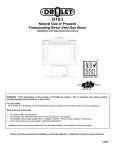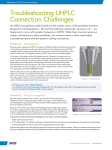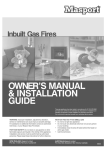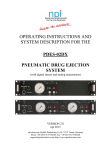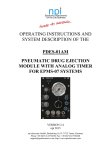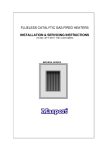Download User`s Manual
Transcript
MicroJect-1000A Pico-Injector User’s Manual USER’S MANUAL Item No. System 45-0758 MicroJect-1000A Basic System 45-0759 MicroJect-1000A Plus System 45-0760 MicroJect-1000A Max System Publication 5506-001-REV-A WEEE/RoHS Compliance Statement EU Directives WEEE and RoHS To Our Valued Customers: We are committed to being a good corporate citizen. As part of that commitment, we strive to maintain an environmentally conscious manufacturing operation. The European Union (EU) has enacted two Directives, the first on product recycling (Waste Electrical and Electronic Equipment, WEEE) and the second limiting the use of certain substances (Restriction on the use of Hazardous Substances, RoHS). Over time, these Directives will be implemented in the national laws of each EU Member State. Once the final national regulations have been put into place, recycling will be offered for our products which are within the scope of the WEEE Directive. Products falling under the scope of the WEEE Directive available for sale after August 13, 2005 will be identified with a “wheelie bin” symbol. Two Categories of products covered by the WEEE Directive are currently exempt from the RoHS Directive – Category 8, medical devices (with the exception of implanted or infected products) and Category 9, monitoring and control instruments. Most of our products fall into either Category 8 or 9 and are currently exempt from the RoHS Directive. We will continue to monitor the application of the RoHS Directive to its products and will comply with any changes as they apply. • Do Not Dispose Product with Municipal Waste • Special Collection/Disposal Required Table of Contents B T X / H a r v a r d A p p a r a t u s M i c r o J e c t - 1 0 0 0 A Pi c o I n j e c t o r U s e r ' s M a n u a l SUBJECT 1 PAGE NO. Warranty and Repair Information ........................................2 General Safety Summary ......................................................3 Specifications ........................................................................4 Introduction ............................................................................5 Preliminaries ........................................................................6-7 Front Panel Controls & Connections ................................8-9 Rear Panel Connectors & Attachments ............................10 Using the MicroJect-1000A Pico-Injector ....................11-13 Micro-Injection Substances/Cell Types ............................14 Setting, Pressure & Time Pulse ............................................14 Gas Usage Warning ............................................................14 Hose Connections................................................................14 Volume Calibration Chart ..................................................15 Power Entry Module ............................................................16 toll-free 800.272.2775 • phone 508.893.8999 • web www.btxonline.com Warranty & Repair Information B T X / H a r v a r d A p p a r a t u s M i c r o J e c t - 1 0 0 0 A Pi c o I n j e c t o r U s e r ' s M a n u a l Serial Numbers All inquires concerning our product should refer to the serial number of the unit. Serial numbers are located on the rear of the chassis. Calibrations All electrical apparatus is calibrated at rated voltage and frequency. Warranty BTX/Harvard Apparatus warranties this instrument for a period of one year from date of purchase. At its option, BTX/Harvard Apparatus will repair or replace the unit if it is found to be defective as to workmanship or material. This warranty does not extend to damage resulting from misuse, neglect or abuse, normal wear and tear, or accident. This warranty extends only to the original customer purchaser. IN NO EVENT SHALL BTX/HARVARD APPARATUS BE LIABLE FOR INCIDENTAL OR CONSEQUENTIAL DAMAGES. Some states do not allow exclusion or limitation of incidental or consequential damages so the above limitation or exclusion may not apply to you. THERE ARE NO IMPLIED WARRANTIES OF MERCHANTABILITY, OR FITNESS FOR A PARTICULAR USE, OR OF ANY OTHER NATURE. Some states do not allow this limitation on an implied warranty, so the above limitation may not apply to you. If a defect arises within the two-year warranty period, promptly contact BTX/Harvard Apparatus, Inc. 84 October Hill Road, Building 7, Holliston, Massachusetts 01746-1371 using our toll free number 1-800-272-2775. Goods will not be accepted for return unless an RMA (returned materials authorization) number has been issued by our customer service department. The customer is responsible for shipping charges. Please allow a reasonable period of time for completion of repairs, replacement and return. If the unit is replaced, the replacement unit is covered only for the remainder of the original warranty period dating from the purchase of the original device. This warranty gives you specific rights, and you may also have other rights which vary from state to state. Repair Facilities and Parts BTX/Harvard Apparatus stocks replacement and repair parts. When ordering, please describe parts as completely as possible, preferably using our part numbers. If practical, enclose a sample or drawing. CAUTION This apparatus is not registered with the FDA and is not for clinical use on human patients. CAUTION: Not for clinical use on human patients. 2 toll-free 800.272.2775 • phone 508.893.8999 • web www.btxonline.com B T X / H a r v a r d A p p a r a t u s M i c r o J e c t - 1 0 0 0 A Pi c o I n j e c t o r U s e r ' s M a n u a l General Safety Summary Please read the following safety precautions to ensure proper use of your pico injector. To avoid potential hazards and product damage, use this product only as instructed in this manual. If the equipment is used in a manner not specified by the manufacturer, the protection provided by the equipment may be impaired. To Prevent Hazard or Injury: USE PROPER POWER SUPPLY The product is supplied with an approved power supply. MAKE PROPER CONNECTIONS Make sure all conections are made properly and securely. ORIENT EQUIPMENT PROPERLY Do not position the equipment such that it is difficult to reach the disconnecting device. OBSERVE ALL TERMINAL RATINGS Review the operating manual to learn the ratings on all connections. AVOID EXPOSED CIRCUITRY Do not touch any electric circuitry inside the product. DO NOT OPERATE WITH SUSPECTED FAILURES If damage is suspected on or to the product do not operate the product. Contact qualified service personnel to perform inspection. OBSERVE ALL WARNING LABELS ON PRODUCT Read all labels on product to ensure proper usage. Protective Ground Terminal CAUTION Refer to Manual CAUTION This product is not registered with the FDA and is not for clinical use on human or veterinary patients. It is intended for research use only. 3 toll-free 800.272.2775 • phone 508.893.8999 • web www.btxonline.com Specifications B T X / H a r v a r d A p p a r a t u s M i c r o J e c t - 1 0 0 0 A Pi c o I n j e c t o r U s e r ' s M a n u a l MicroJect-1000A Pico-Injector Specifications 4 Input Gas Pressure 70-105 psi (480 - 720 kPa) Injection Pressure 0.2 - 60.0 psi (413 kPa) - regulated, multi-turn control Balance Pressure 0.1 -9.9 psi (68.9 kPa) - regulated, multi-turn control Fill Pressure 0 + 0-12 psi (-82 kPa) (Vacuum) Hold Pressure -0 to 1.25 kPa (-12.7 cm. of water) (Vacuum) Clearing Pressure Inlet pressure (unregulated) Injection Time 0.01-.99 sec.; 1-99 sec. Pressure Display Resolution 3.5 digits, 0.1 PSI or IKPA Injection Count Display 0-9999 Duration Mode Internally timed or externally gated Trigger Mode Front Panel, Foot Switch, external TTL pulse BNC Pressure Monitor Out BNC Connector, 10 mV/psi or 1mV/KPa AC Power Lines External 9V DC@ 400mA (min) Power Supply universal input 90 to 264 VAC Accessories Supplied Input hose, output hose, holding hose and power module Weight 12 pounds (5.44 kg) Dimensions (H x W x D) 3.5 in x 17 in x 9.8 in (89 mm x 432 mm x 250 mm) Optional Accessories Foot Switch(es) up to four functions, Pipette Holder - up to 2, Input Hose Adaptor Warranty Two-year, parts and labor toll-free 800.272.2775 • phone 508.893.8999 • web www.btxonline.com B T X / H a r v a r d A p p a r a t u s M i c r o J e c t - 1 0 0 0 A Pi c o I n j e c t o r U s e r ' s M a n u a l Introduction 5 The MicroJect-1000A Pico-Injector allows small liquid volumes to be delivered precisely through micropipettes by applying a regulated pressure for a digitally set period of time. The pressure is applied pneumatically (compressed gas) to deliver volumes from microliters to femtoliters from the same instrument. This digital injection pressure is enhanced by three auxiliary pressures: FILL: Suction can be applied to the delivery pipette to fill it from the tip. HOLD: A second internal vacuum pump is available to hold a suspended cell (for injection)with a second holding pipette. BALANCE: A (lower) balance pressure applied to the delivery pipette between injections prevents clogging caused by pipette movement as well as dilution of the injected material by capillary action. CLEAR: Momentary application of high pressure can be used to clear clogged pipettes. Triggering of injection is accomplished three ways: panel push button, optional foot switch, or an externally applied electrical signal (TTL pulse). The duration of injection can be determined by an internal clock set with a digital switch or can be gated by the duration either of an externally applied electrical pulse or of the depression of an optional foot switch. This manual assumes the reader has no previous experience with microinjection, either extracellular or intracellular. Those planning on larger volume delivery (100 pL and up) can ignore the BALANCE feature. Some reference will be made to a less precise technique for smaller volume delivery to highlight the precision determining features of this instrument. This technique involves pressurizing the gas in a macro-syringe attached to a delivery micropipette by advancing the piston of the syringe with a micrometer screw. Ejection takes place continuously from the pipette: the volume delivered depends both on the unregulated over pressure in the syringe and the poorly known time the pipette is left inside the cell. This continuous ejection technique supposedly reduces the frequency of pipette clogging. Reliable microinjection also requires skill in making and using micropipettes. Authorities on microinjection state that the most important single factor in microinjection is the micropipette.The MicroJect-1000A Pico-Injector with its reproducibility simplifies the search for the optimum micropipette. toll-free 800.272.2775 • phone 508.893.8999 • web www.btxonline.com Preliminaries B T X / H a r v a r d A p p a r a t u s M i c r o J e c t - 1 0 0 0 A Pi c o I n j e c t o r U s e r ' s M a n u a l Microinjection Microinjection also involves other skills, several other instruments and accessories, and various supplies.The purpose of this section is to give an overview of these techniques for those new to microinjection: some guidance on equipment selection is also supplied. Required Auxiliary Equipment for Microinjection The required equipment includes a pipette puller and micromanipulator(s). Ideally, the puller should be capable of making pipettes with tip diameters in the 0.2 to 1.57 micron range with a short enough taper length for both mechanical strength and low flow resistance. If most injections are to be extracellular, then a puller suitable for extracellular patch clamp pipettes is satisfactory. For intracellular injections, some magnetic pullers may be suitable. Alternatively, a two stage gravity puller with variable weights can be satisfactory over the entire range.The required three dimensional movement can be produced by an inexpensive mechanically linked micromanipulator for large cells such as frog oocytes. More commonly, a hydraulic one for fine, vibration-free movement is mounted on a coarse mechanical manipulator. Suitable equipment is available from Harvard Apparatus, Inc. Required Supplies These are compressed gas and microcapillaries. Compressed air is suitable for oxygen insensitive injection material. Nitrogen is a satisfactory inert gas for the general case. A pressure of 105 psi is sufficient: a regulator will be needed if supplied from a bottle of compressed gas. Optional Equipment for Microinjection This includes a microforge (to bend a micropipette or to polish a pipette tip for holding a cell), a microgrinder (to bevel the pipette tip to increase the delivery rate without additional cell damage), and an micro-incubator (to hold the cells at incubation temperatures during microinjection). Suitable equipment is available from Harvard Apparatus, Inc. Accessories These are also available to enhance your MicroJect-1000A Pico-Injector (see Price List). Micropipettes The micropipettes are made with a pipette puller from a microcapillary (1-2 mm. in diameter) by heating some 3-10 mm. of its length with a concentric heater while applying a force (gravitational or magnetic) to pull both ends of the capillary apart. Two micropipettes are produced per capillary. 1. Distinguishing Parameters Two useful distinguishing parameters of the micropipette are the inside diameter of its tip and the angle of taper to the tip.The smaller this angle, the longer the tapered region. The larger the tip, the more material is delivered for the same applied pressure and time. Just a 10% decrease in diameter decreases the delivery rate by over 30%. A 10% decrease in taper angle (longer taper) would decrease the delivery rate about 10%.The extreme sensitivity of delivery rate on tip diameter makes it important to have a reproducible pipette puller. If you use published tip sizes as a starting point, distinguish between the relevant inside diameter and the more visible outside diameter. (The ratio of the two is the same at the tip as for the original capillary glass.) 6 toll-free 800.272.2775 • phone 508.893.8999 • web www.btxonline.com Preliminaries B T X / H a r v a r d A p p a r a t u s M i c r o J e c t - 1 0 0 0 A Pi c o I n j e c t o r U s e r ' s M a n u a l Micropipettes (continued) 2. Choosing the Right Pipette Choosing a pipette size and shape for intracellular injection is difficult. Larger tips deliver more material but increase the risk of cell damage caused by leakage around the pipette while in the cell or later by incomplete sealing. The smaller the cell, the smaller the pipette tip it will tolerate. The smaller the tip, the more likely it is to clog. For reference, intracellular electrophysiologists routinely record for an hour or so from cells of 10 micron diameter with pipette tips of 0.1 micron inside diameter. Larger tips can therefore be used for brief injection in such cells. For nuclear injections, a smaller taper angle is needed to avoid leakage further up the shank of the pipette at the plasma membrane. Although even intracellular injection can be done from below with an upright microscope, most injections are done from the side or from above the cells. Four different strategies have been used to suitably fix the cell in position for successful intracellular injection. For suspended cells, a second, larger pipette is used to hold the cell. This pipette’s tip is first polished with a microforge (done by placing the pipette within 5 microns of a hot filament for a few seconds). With its axis horizontal, it is moved to hold the cell with applied suction. The injection pipette is also straight and is inserted horizontally from the opposite side. This geometry avoids damage to the cell membrane caused by shearing forces. The optics are straightforward because the pipettes remain in focus as they are advanced. For cells that can be or are attached to a surface in a closely packed layer, straight injection pipettes can also be used. In this case, the pipette axis slopes slightly down from the horizontal. The tendency of the cells to slide when the pipette enters is resisted by the extracellular environment or attachment to the culture surface. The microscope should be focused on the cell’s surface. The pipette tip then comes into focus just before injection. If the cell is nearly spherical (the hardest case), the pipette should again enter the cell membrane at right angles to avoid shearing. Non spherical cells ( for example, cultured fibroblasts) have a more robust cytoskeletal structure so the pipette can be pushed in even if not perpendicular to the membrane surface. For less firmly attached cells, the injection pipette can be bent near the tip after pulling. The pipette’s main axis slopes slightly down from the horizontal. The angle of bend should allow the tip to point straight down. With an inverted microscope, the tip is viewed through the cell as it is lowered for injection. The microscope is focused on the cell’s top surface and the tip comes into focus just before insertion. Again shearing forces are avoided. (Suitable bends can be made with a microforge: a simple way to do this is to move the pipette near a hot filament at the position of desired bend. The tip will spontaneously bend away). In all of the above techniques, a three dimensional micromanipulator controls the movement of the injection pipette. If this (straight) pipette is instead attached to a condenser mount (inverted scope), then a one dimensional manipulator can be used. The remaining two directions of manipulation are done with stage micrometers moving the vertical injection pipette over each cell in turn. If the vibrations transmitted with the condenser mounting are manageable, then this approach gives the fastest rate of cell injection. 7 toll-free 800.272.2775 • phone 508.893.8999 • web www.btxonline.com Front Panel Connectors & Controls 9 2.1 B T X / H a r v a r d A p p a r a t u s M i c r o J e c t - 1 0 0 0 A Pi c o I n j e c t o r U s e r ' s M a n u a l 6 8 16 2 14 13 17 19 4 1 22 10 7 15 3 11 18 20 21 12 5 Figure 1: Front Panel Refer to Figure 1 for the location of controls and connectors. Numbers refer to the order of listing below. 1. INJECT pushbutton Push this to manually trigger the injection pressure for a time set by the internal timer. The switch remains lit for the duration of the injection. 2. INJECT TIME SETTING DIAL This dial controls the injection time setting. Turning the dial changes the injection time in seconds; pressing the dial in and turning changes the injection time in fractions of a second. 2.1 INJECT TIME Display Displays injection time in seconds. 3. CLEAR pushbutton Push this briefly to deliver a half second pressure surge to clear a clogged pipette. The pressure applied is the supply pressure. If the button is left pushed in for longer than a half second, the clearing surge is extended. The button remains lit for the duration of the clear. 4. FILL pushbutton Push the button to apply suction to the delivery pipette to fill it from the tip. The suction is applied as long as this button is held and LED is lit. 5. HOLD pushbutton Push this button to apply sufficiently small suction to holding pipette (LED is lit) to hold a cell for injection. Push this a second time to drop this suction to zero. 6. PRESSURE display This three digit display gives the “gauge” pressure selected by the PRESSURE METER SELECT switch. A negative (-) sign indicates suction. 7. PRESSURE UNITS toggle switch Toggle switch controls injection pressure display unit of measure. Injection pressure can be displayed in either pound-force per square inch (PSI) or in kilopascals (kP.) 1 psi = 6.89 kP. 8. RESET pushbutton This button resets the injection count display to zero. 9. INJECTION COUNT display This four digit display (0-9999) gives the total number of injections triggered manually by the panel pushbutton or footswitch or electrically since the last reset. 8 toll-free 800.272.2775 • phone 508.893.8999 • web www.btxonline.com Front Panel Connectors & Controls B T X / H a r v a r d A p p a r a t u s M i c r o J e c t - 1 0 0 0 A Pi c o I n j e c t o r U s e r ' s M a n u a l 10. PRESSURE METER SELECT switch This switch selects various places inside the PICO-INJECTOR for reading the pressure. It does not change the pressure applied to the output. PINJ is the pressure applied to pressure applied at the output during injection. PBAL is the pressure applied to the pipette when injection is not taking place. PCLR is the pressure externally supplied to the input on the rear panel and used the CLEAR mode. PFILL is the negative pressure applied to fill the injection pipette from the tip. POUT is the pressure currently applied to the output port. 11. P INJ regulator This seven turn control is used to set the injection pressure over the range from about 0.4 to 60.0 psi (about 2.8 - 413 kP). Clockwise rotation increases the pressure. Locking nut should be loose to avoid damaging the shaft's threads if changing pressure constantly. 12. POWER rocker switch Controls power to the unit. 13. TRIG IN connector This BNC connector is for electrically initiating injection. A positive TTL level pulse is required (baseline 0.0 V, trigger 5 V, lasting at least 50 microseconds). 14. GATE IN connector This BNC connector is for external timing of the duration of injection. A positive TTL level pulse (see 13.) is required with the duration of injection determined by the duration of the applied pulse. 15. TRIG/GATE OUT connector This TTL output (see 13.) can be used to trigger or synchronize other electrical instruments. Its duration is that of the injection. 16. PRESSURE MONITOR out This BNC connector delivers an electrical level whose amplitude gives the actual pressure applied to the meter.The conversion factor is 10 mV /psi or 1mV/KPa. 17. FILL VACUUM regulator This regulator sets the vacuum applied to the POUT connector. The range is 0 to -12 PSI (0 to -82KPa, regulated. 18. POUT connector This connector is attached to the injection pipette using the supplied output hose (PLI-OH). Without the hose attached the port is closed. In use, the injection, balance, fill, and clear pressures are delivered here. 19. PHOLD regulator This regulator sets the (low) suction pressure applied to the PHOLD connector. Counterclockwise increases the pressure. Like the other pressure controls the current rotational position is uniquely related to the pressure. The range is 0-0.5 kP. ( 5 cm. height of water). 20. PHOLD connector The supplied holding hose is attached to this connnector. The suction set by the PHOLD regulator is applied here to hold a suspended cell for injection. 21. PBAL regulator This regulator sets the balance pressure over the range from 0.1 to 10 psi. (about 0.7-70 kP.). Clockwise rotation increases the pressure. 22. AUDIO / MUTE switch Controls injection sound. 9 toll-free 800.272.2775 • phone 508.893.8999 • web www.btxonline.com B T X / H a r v a r d A p p a r a t u s M i c r o J e c t - 1 0 0 0 A Pi c o I n j e c t o r U s e r ' s M a n u a l Rear Panel Connectors & Attachments 5 2 3 1 4 Figure 2: Rear Panel 1. Foot Switch Inputs (Connectors) An optional footswitch (PLI-FS) can be connected to any one of these connectors. When connected to HOLD, pushing the footswitch once turns on the suction for holding a cell. Pushing it a second time turns that suction off. When connected to INJ, pushing the footswitch starts injection. When connected to FILL, the filling suction is applied as long as the footswitch is depressed. When connected to GATING, injection pressure continues as long as the footswitch is depressed. 2. Pressure Input Connector To have all the functions working, the instrument needs 70 to 105 psi. To have only injection, 70 psi is needed. This connector is the input for the compressed gas. See PRELIMINARIES for recommendations on the gas. A maximum of 105 psi. can be safely applied; 100 psi. is optimal. At lower pressure gas will be used at a slower rate. Avoid input pressures less than 100 psi if the FILL function is being used. 3. Input Filter The PICO-INJECTOR is supplied with an input filter. It traps particles larger than 0.5 micron as well as the liquid often present in a building’s compressed air lines. Drain by pushing the button on the underside of its transparent case. Through a hole located in the bottom case. 4. Filter Window Allows for easy viewing of filter to determine when it needs to be drained. 5. Power Input Connector Jack for universal AC input 9 volt 6 watt DC output power supply. 10 toll-free 800.272.2775 • phone 508.893.8999 • web www.btxonline.com Using the MicroJect-1000A Pico-Injector B T X / H a r v a r d A p p a r a t u s M i c r o J e c t - 1 0 0 0 A Pi c o I n j e c t o r U s e r ' s M a n u a l General Considerations 11 It is much easier to reliably inject large volumes than small ones. For “large” volumes, the balance pressure capability is not needed. Pipettes seldom clog so the clear capability is also not needed. The dividing line between large and small is not rigid: it depends on how quantitative a delivery is required. That volume line would typically be in the 10-100 pLiter range. (For convenient visualization and approximate geometric measurement, 1 fLiter is a cube 1 micron on a side or a sphere 1.24 microns in diameter, 1 pLiter is a cube 10 microns on a side or a sphere 12.4 microns in diameter, while 1 nLiter is a cube 100 microns on a side or a sphere 124 microns in diameter. Because volume goes as the cube of linear dimensions, such geometric volumes are imprecise, but often useful). Extracellular delivery is nearly always “large”. Intracellular is often of “small” volumes (but not for frog oocytes). A more quantitative way to distinguish between “large” and “small” is given in the balance section below. Interconnections and Initial Set-Up Connect the gas input hose to the rear panel input connector of the MicroJect-1000A Pico-Injector. Connect the other end (with optional input hose adapter, if needed) to the gas supply. Turn on the POWER switch and verify the input gas pressure with the digital meter by setting the PRESSURE METER SOURCE switch to PCLR. Practice with the inject and balance pressure controls by first turning the METER SELECT switch and then adjusting each in turn. With non zero values of inject and balance pressure set the PRESSURE METER SOURCE switch to POUT. NOTE: The PRESSURE METER SELECT switch must be set to POUT to read changes in pressure on the display or MONITOR output. Set the inject time to five seconds and push the panel INJECT switch to see the temporary change in pressure from balance to inject and back. (A buzzer will sound during injection. If this is not wanted, turn off the switch on the rear panel.) Two output hoses are supplied with the MicroJect-1000A Pico-Injector. These are designed for any of the three optional pipette holders described in the PRICE LIST. Connect the hoses to the chosen holder(s) as follows: MicroJect-1000A Pico-Injector: Unscrew the end of the holder with a 2 mm diameter hole. This end hex piece should be placed over the tube end. Thread the hex piece on the holder and tighten firmly. The 1 mm OD capillary is inserted in the opposite end of the holder through its “o” ring (silicon rubber gasket) and its fitting is then tightened. toll-free 800.272.2775 • Fig. 3. MicroJect-1000A 1.0 mm OD Glass Pipette Assembly phone 508.893.8999 • web www.btxonline.com B T X / H a r v a r d A p p a r a t u s M i c r o J e c t - 1 0 0 0 A Pi c o I n j e c t o r U s e r ' s M a n u a l Using the MicroJect-1000A Pico-Injector MicroJect-1000A Pico-Injector: Unscrew the end of the holder with the 2 mm. diameter hole and place it over the output hose (PLI-OH). Reattach this fitting securely with the hose inserted as far as it will go. The 1.5 mm. OD capillary is similarly attached to the other end of the holder through its “o” ring. Hex Nut Output Hose Holder Bushing (Metal Sleeve) Silicon Rubber Gasket (7.5mm L x 1.5mm ID) Knurled Nut Glass Tube Fig. 4. MicroJect-1000 1.5 mm OD Glass Pipette Assembly Attach output and holding hose to the appropriate front panel gas ports. Tighten them securely so that the valves within these ports are open, allowing pressure to be controlled in the hose and connecting micropipette. Micropipette Filling Filling can be done from the tip of the micropipette, or, with a few extra steps, from the barrel of the pipette. Filling from the tip is most suitable if a filling fiber is deliberately not being used due to irregularities in the balancing (see BALANCE below). Simply prepare a bolus of injection material on a glass slide and maneuver the tip into it using a micromanipulator. Depress the FILL button to apply about 12 psi (82 kP.) of suction continuously as long as needed. If evaporation of a small bolus is a concern, it can be prepared under oil and the micropipette tip similarly moved into it. Filling can be done from the back end (barrel) of the pipette using a syringe with a thin hypodermic needle inserted so its tip is down in the tapered section. If the capillary has a filling fiber attached to the inner wall the pipette tip will then fill by capillary action without air bubbles, at least for larger tips. Variations on this procedure involve filling a smaller capillary first and inserting it for the back fill. Balance The inflow into the pipette (caused by capillary forces) prior to or in-between injections should be a small percentage of that being injected. As the volume desired gets smaller, the relative inflow gets larger even faster due to the smaller tip size being used. To avoid this problem, set the balance pressure before placing the pipette in the cell’s external medium. Ten percent of the injection pressure is a good starting value. Exact balance is difficult to determine: often the fastest way to handle this is to set the balance high enough that slight outflow is observed. Balance is assessed by watching the movement of the liquid meniscus in the pipette. The outflow left is still small compared to the continuous streaming used in the continuous ejection technique. If a filling fiber is used, the capillary inflow is larger so a higher balance pressure is needed. In general, however, when a balance pressure is being used, such a fiber should not be used: sometimes the injection material will run out spontaneously or the pressure needed to balance will abruptly change with time. (These may be due to particles lodging on the fiber). 12 toll-free 800.272.2775 • phone 508.893.8999 • web www.btxonline.com Using the MicroJect-1000A Pico-Injector B T X / H a r v a r d A p p a r a t u s M i c r o J e c t - 1 0 0 0 A Pi c o I n j e c t o r U s e r ' s M a n u a l Balance (continued) If desired, a rough estimate of the volume coming in can be made. Focus the microscope on the liquid meniscus in the loaded pipette while its tip is still in air (with the balance pressure set to zero). Use an eyepiece reticle to measure the meniscus movement when liquid is then raised to cover the tip. The inflow volume is approximately the difference between the volume of two cones. The estimate is more precise for smaller initial volumes in the pipette. Clear To clear a clogged micropipette, push the CLEAR button momentarily once the tip has been removed from a cell. Watch the tip region while this is done to see the brief movement of liquid denoting that the tip is clear. Repeat if needed. The clearing pressure pulse has a preset duration of 500 msec. to avoid excessive release if the clog clears immediately. Repeat as needed. Hold To hold a suspended cell for injection, attach a suitable holding pipette to the pipette holder/holding hose. Momentarily attach to the P OUT port. Backfill the holding pipette (using the fill function switch) with fluid so that tube length is half to three quarters filled.* Disconnect the holding hose connector from the P OUT port and attach to the P HOLD port. Set the hold pressure control to minimum and move the micropipette to the cell using a micromanipulator. Turn on the HOLD panel switch and increase the hold pressure as needed. When finished with that cell turn off the hold pressure with the panel or footswitch. If more cells of the same kind are being injected then subsequent holds require only the ON/OFF control of the switch. If the cell doesn’t drop off the holding pipette tip when hold is turned off, a brief, gentle squeeze of the rubber bulb located on the holding output hose should release it. *Note: Be careful not to overfill the hose to avoid liquid going into the pneumatic system inside the unit. Footswitch(es) Optional footswitches can be used for inject, fill, and turning on and off the hold function. These switches are plugged into the rear panel: each is wired in parallel with the corresponding front panel switch. See the instructions for each panel switch to see how they operate.When a footswitch is used with the GATE connector, the duration of injection is manually determined by the duration of pressing the footswitch. In some applications, users may prefer to set up the duration of injection manually: connect the MONITOR output to an oscilloscope or fast enough strip chart recorder to measure this time and then switch to the internal timer for subsequent injections. Electrical Inputs/Outputs (13-16 in Figure 1) These connectors allow additional control, especially when synchronizing injection to other stimulations or recording. See items 13-16 on pages 8 and 9 for details. In particular, the PRESSURE MONITOR output signal is a precise measure of relative injection volume ( for a given pipette). Since the volume delivered is linear in the net injection pressure (P INJ -P BAL and injection time, the area under a graph of this signal versus time is a measure of the relative volume. Injection Volume Adjustment Adjust injection volume by changing either injection pressure, injection duration, or the micropipette (inside) tip diameter or taper.The dependence on (net) injection pressure, duration and pipette taper angle is linear; the dependence on tip diameter is cubic. 13 toll-free 800.272.2775 • phone 508.893.8999 • web www.btxonline.com General Information B T X / H a r v a r d A p p a r a t u s M i c r o J e c t - 1 0 0 0 A Pi c o I n j e c t o r U s e r ' s M a n u a l Micro-Injection Substances/Cell Types A wide range of substances have been micro-injected onto or into a large number of cell types. References 10-17 on page 16 give some recent examples. Setting Pressures and Time Pulses 1. Balance Pressure Set the balance pressure while viewing the pipette under magnification. This method will help the user to stabilize the solution within the pipette easily. 2. Injection Pressure and Time Pulse Setting the initial injection pressure low prevents the loss of solution. To easily obtain the desired pressure setting, set the time pulse on (1) one second with the injection pressure set at its minimum. Trigger the time pulse while viewing under magnification. Increase the injection pressure until the solution within the pipette begins to flow out the tip opening. The pressure shown on the LCD can now be used as the initial injection pressure setting. Adjust the injection pressure and timing to obtain the desired injection 3. Holding Pressure Set the holding pressure at the minimum. This will prevent possible damage to the cell. Fill 3/4 of the pipette’s capillary tube with a solution (medium). This serves as a buffer, when the holding function is 2Z preventing a constant vacuum at the pipette tip caused by capillary action. Gas Usage Warning To provide finely controllable output pressure, the gas regulators are of the “bleeding” type. Such regulators use gas even in the absence of ejections. The MicroJect-1000 Pico-InjectorA thus uses gas even when off. To eliminate this consumption and as a good safety practice, turn off the gas supply at the source when the MicroJect-1000A Pico-Injector is not in use. The suction functions (HOLD and FILL) use much more gas than INJECT and BALANCE. Plan accordingly. Notice, that the BALANCE is on continuously once an output hose is attached to the front panel: without a micropipette attached, even this gas usage can be significant. Hose Connections The input, output, and holding hoses should be attached to their respective connectors. If each connector’s needle valve, located in the micro-injector body, is not fully opened, the airflow will be restricted or blocked. To prevent this from happening, check each connector for tightness by turning clockwise. This will ensure needle valve depression. 14 toll-free 800.272.2775 • phone 508.893.8999 • web www.btxonline.com Volume Calibration Chart FORMULA B T X / H a r v a r d A p p a r a t u s M i c r o J e c t - 1 0 0 0 A Pi c o I n j e c t o r U s e r ' s M a n u a l Volume in Nanoliters = .17952(*) x (tip I.D. in micron)3 x (Pressure in psi) x (Time in sec) EXAMPLE Volume = .17952 x (5)3 X (10) X (1) Nanoliters = 224.40 Nanoliters Pressure Time Pipette Tip (p.s.i.) (sec.) I.D. (µm) Femtoliters Picoliter 1 10 20 30 40 50 60 1 10 20 30 40 50 60 1 10 20 30 40 50 60 1 10 20 30 40 50 60 1 10 20 30 40 50 60 1 1 1 1 1 1 1 1 1 1 1 1 1 1 1 1 1 1 1 1 1 1 1 1 1 1 1 1 1 1 1 1 1 1 1 0.1 0.1 0.1 0.1 0.1 0.1 0.1 1 1 1 1 1 1 1 5 5 5 5 5 5 5 10 10 10 10 10 10 10 75 75 75 75 75 75 75 179.52 1795.20 3590.40 5385.60 7180.80 8976.00 10771.20 - Nanoliter Microliter Milliliter 0.18 1.80 3.59 5.39 7.18 8.98 10.77 22.44 224.40 448.80 673.20 897.60 1122.00 1346.40 179.52 1795.20 3590.20 5385.60 7180.80 8976.00 10771.20 - 0.08 0.76 1.51 2.27 3.03 3.79 4.54 0.18 1.80 3.59 5.39 7.18 8.98 10.77 179.52 1795.20 3590.40 5385.60 7180.80 8976.00 10771.20 - 0.02 0.22 0.45 0.67 0.90 1.12 1.35 0.18 1.80 3.59 5.39 7.18 8.98 10.77 75.74 757.35 1514.70 2272.05 3029.40 3786.75 4544.10 (*) Constant includes unit conversion factors, and effects of water like viscosity and needle taper for a cone half angle of 10 (medium taper). 15 toll-free 800.272.2775 • phone 508.893.8999 • web www.btxonline.com Power Entry Module (PEM) B T X / H a r v a r d A p p a r a t u s M i c r o J e c t - 1 0 0 0 A Pi c o I n j e c t o r U s e r ' s M a n u a l The Microject 1000A is equipped with a universal AC input 9 volt 6 watt DC output power supply with interchangeable input blades. Figure 1: Wall adapter with interchangeable input blades blade lock 1. Slide the blade lock in the direction of the arrow with one hand and lift out the contact protector with your other hand. Figure 2: Remove contact protector Rounded corners 2. Align the rounded corners of the input blade being installed with the rounded corners on the adapter. 3. Lower the square corners of the blade into the adapter. 4. Pull back on the blade lock and lower the rounded corners into adapter, release the blade lock. Figure 3: Install input blade Figure 4: Complete assembly 16 toll-free 800.272.2775 • phone 508.893.8999 • web www.btxonline.com There are many reasons to visit our website online at any time! • Register for newsletters and technical updates • View a complete listing of BTX distributors worldwide • Contact us for a quotation or technical support • Search our products • Submit protocols • To Order, contact BTX customer service today! 800.272.2775 (USA & Canada) 508.893.8999 fax 508.429.5732 toll-free phone customer/technical support e-mail and website: [email protected] w w w. b t x o n l i n e . c o m























